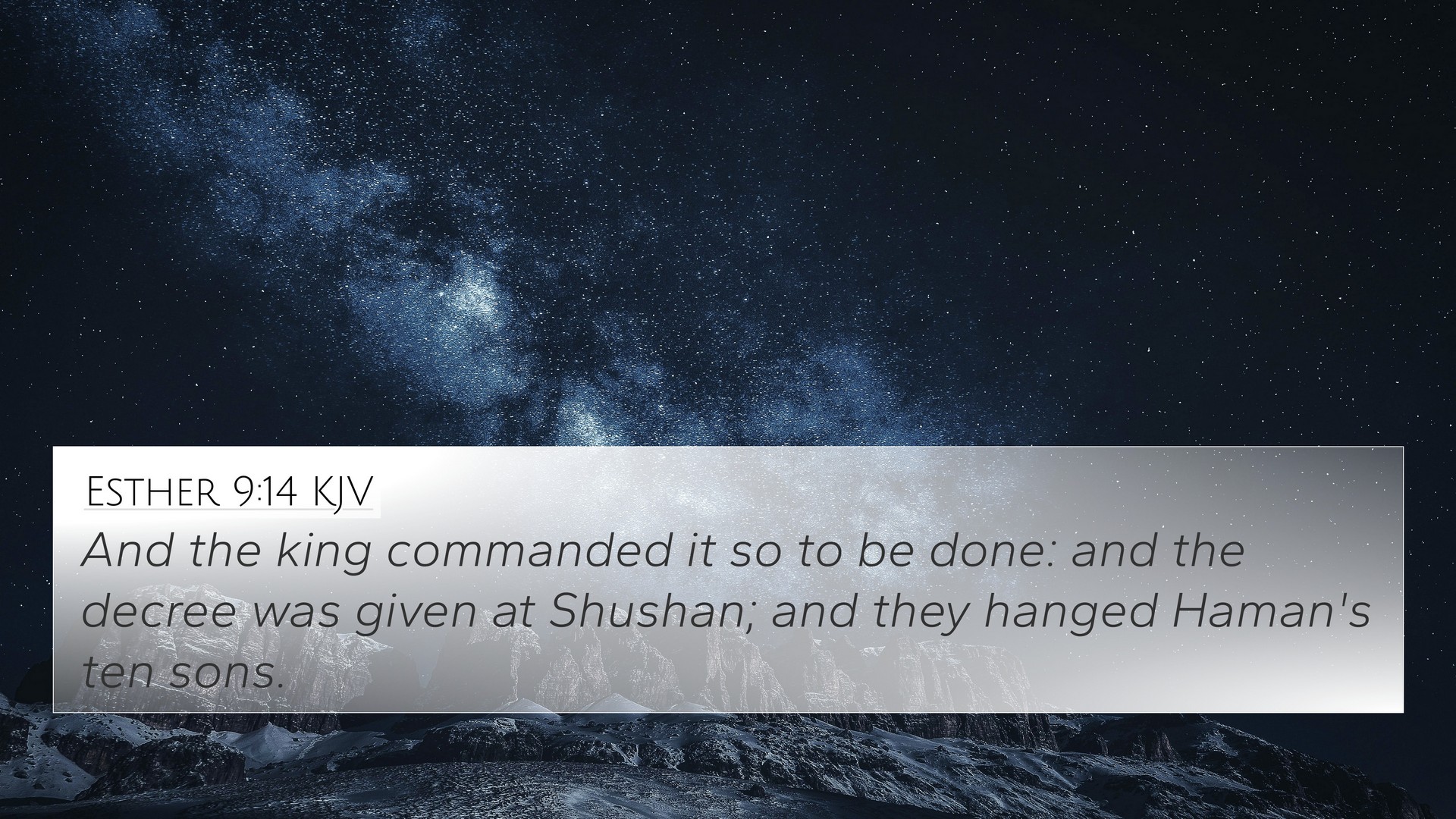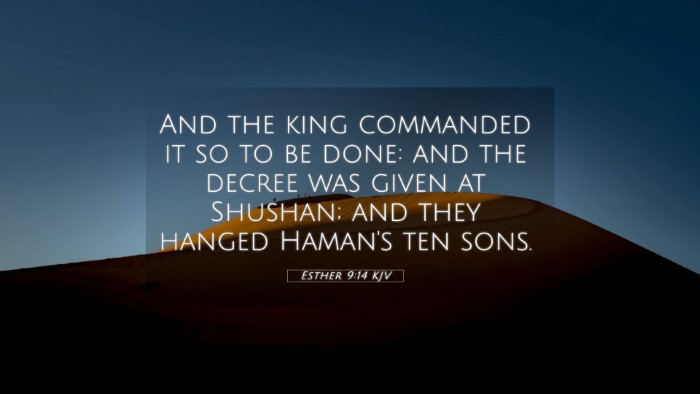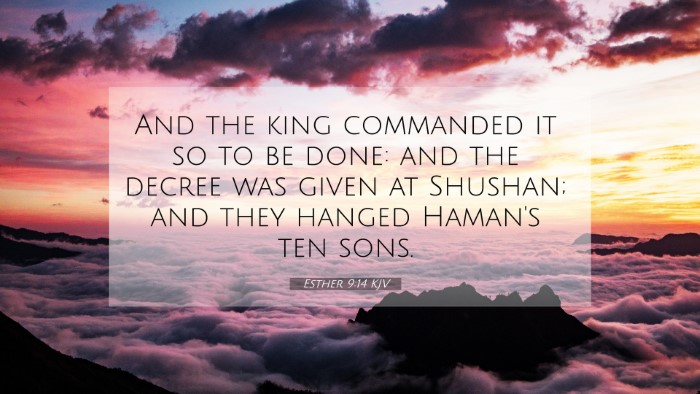Understanding Esther 9:14
Esther 9:14 states, "And the king commanded that it be so done: and a decree was given at Shushan; and they hanged Haman's ten sons." This verse concludes the narrative concerning the fate of Haman and his sons, reflecting the themes of justice and retribution that recur throughout the Book of Esther. Below, we will explore various interpretations and connections of this verse as noted by prominent commentaries, while also linking it to other relevant Bible verses.
Verse Meaning and Commentary Insights
Esther 9:14 serves as an important moment in the unfolding drama of Esther, illustrating the principles of divine justice and the consequences of evil acts. This verse has been elaborated upon by several public domain commentators:
-
Matthew Henry: In his exposition, Henry notes that the execution of Haman’s sons not only serves as a significant act of justice against Haman’s plot to annihilate the Jews but also symbolizes the end of an era of hatred and oppression. Henry emphasizes the merciful victory of the Jewish people and how divine intervention turned their mourning into joy.
-
Albert Barnes: Barnes remarks on the decree given by the king, which underscores the authority and finality of the royal command. In his interpretation, he connects Haman's demise to the overarching theme of reversal found in the Book of Esther, where the oppressed are exalted, and the oppressors are brought low. This reinforced sense of justice serves as a lesson on the moral order and accountability before God.
-
Adam Clarke: Clarke provides insights on the significance of Haman's sons’ execution as a means of complete retribution for their father’s wickedness. He points to the cultural context within which such actions were viewed as necessary and justified. Clarke’s commentary encourages reflection on the balance of justice and mercy in God's governance of human affairs.
Bible Verse Cross-References
To foster a deeper understanding of Esther 9:14, it is helpful to examine cross-references that relate to the themes outlined in this verse. Below are several passages that resonate thematically or contextually:
- Esther 7:10: "So they hanged Haman on the gallows that he had prepared for Mordecai." - This earlier verse sets the stage for the justice that culminates in Esther 9:14.
- Galatians 6:7: "Be not deceived; God is not mocked: for whatsoever a man soweth, that shall he also reap." - Reflects the moral principle of retribution akin to Haman’s fate versus the Jews’ deliverance.
- Proverbs 11:5-6: "The righteousness of the perfect shall direct his way: but the wicked shall fall by his own wickedness." - Aligns with the principle that Haman's evil ultimately led to his downfall.
- Psalm 7:14-16: "Behold, he travaileth with iniquity, and hath conceived mischief, and brought forth falsehood. He made a pit, and digged it, and is fallen into the ditch which he made." - Another illustration of how evil intentions come back upon the perpetrator.
- Job 4:8: "Even as I have seen, they that plow iniquity, and sow wickedness, reap the same." - Highlights the cyclical nature of justice similar to Esther's narrative.
- Revelation 20:10: "And the devil that deceived them was cast into the lake of fire and brimstone." - Represents final justice for those who oppose God.
- Proverbs 29:16: "When the wicked are multiplied, transgression increaseth: but the righteous shall see their fall." - A reminder of the consequences of evil deeds, as illustrated by Esther 9.
- Matthew 23:34-36: "Wherefore, behold, I send unto you prophets, and wise men, and scribes..." - Warns of the fate that awaits those who persecute the righteous.
- Jeremiah 51:24: "And I will render unto Babylon and to all the inhabitants of Chaldea all their evil that they have done in Zion in your sight, saith the LORD." - Signifies how God renders justice against His enemies.
- Ezekiel 18:30: "Therefore I will judge you, O house of Israel, everyone according to his ways, saith the Lord GOD." - Conveys the principle of individual accountability, connecting to Haman's fate.
Thematic Connections
Esther 9:14 is rich with thematic connections that recur throughout scripture. Themes of justice, divine sovereignty, and the reversal of fortunes are present, paralleling stories found in both the Old and New Testaments.
Justice and Retribution
The execution of Haman and his sons echoes throughout scripture where justice is a fundamental characteristic of God. As stated in Romans 12:19, believers are reminded not to avenge themselves, but to leave room for God’s wrath, as retribution belongs to Him.
Deliverance of the Righteous
The deliverance of the Jews in Esther is a powerful account reminiscent of other redemption stories, such as the Exodus. Exodus 14:13-14 illustrates a similar providential deliverance when God parted the Red Sea.
Conclusion
Esther 9:14 is not merely a historical record but a profound statement about divine justice and the consequences of rebellion against God’s people. The insights from traditional commentaries provide valuable reflections on this theme, while the connections we have drawn through various cross-references create a broader understanding of the narrative within the sacred text. Utilizing tools for Bible cross-referencing can enhance our study, revealing the interconnectedness of Scripture and deepening our comprehension of God's word.


